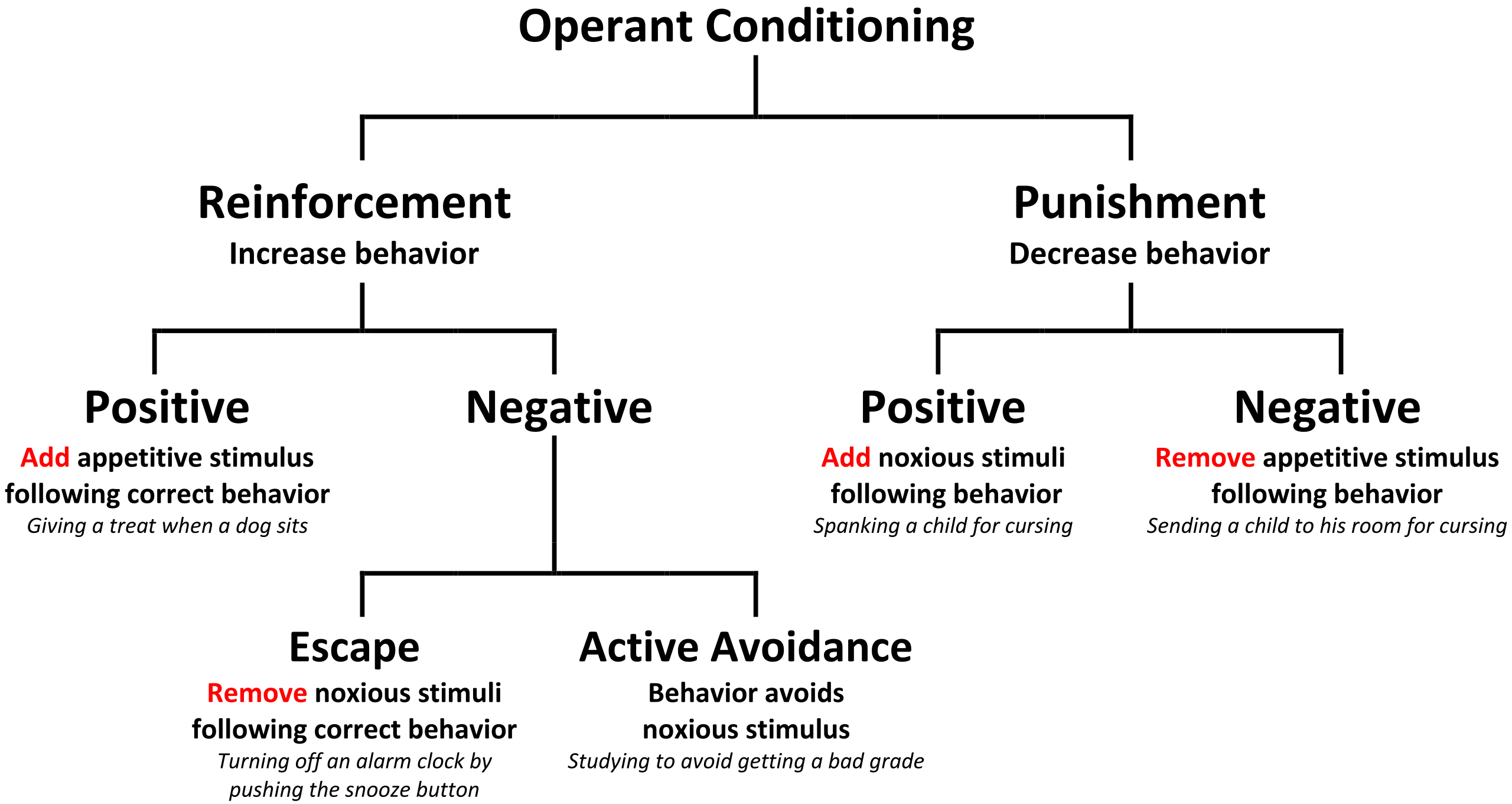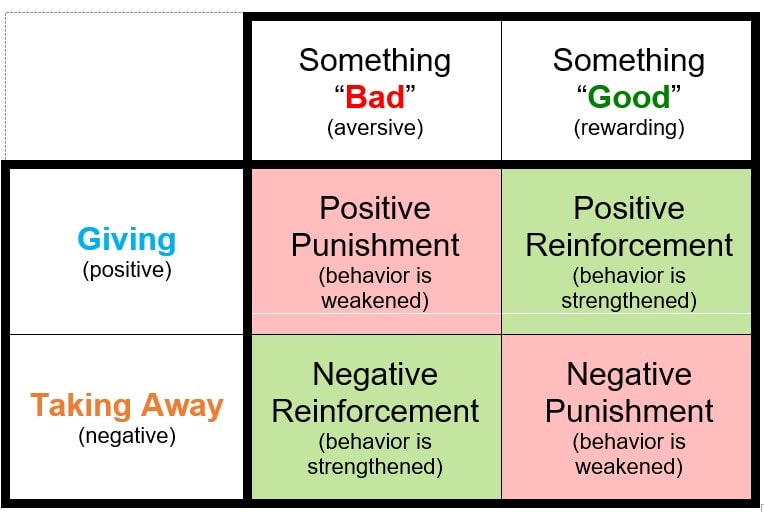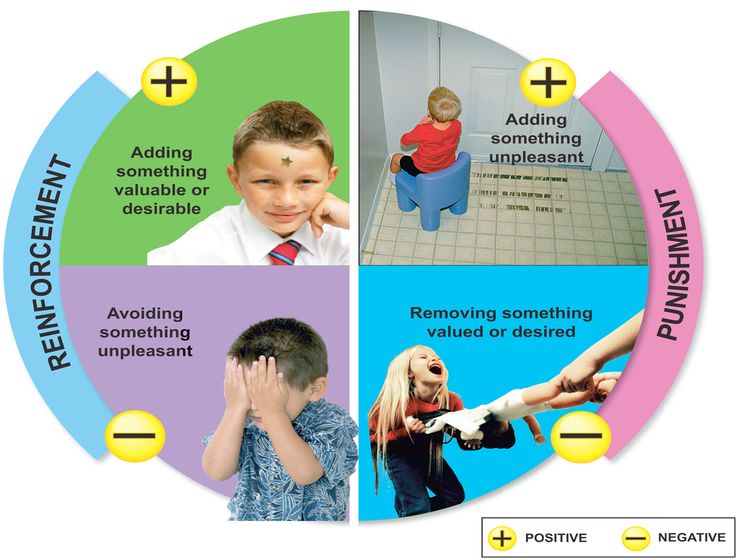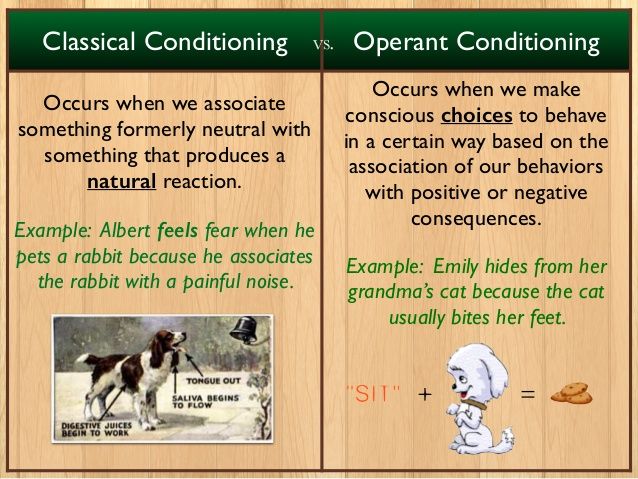Operant Conditioning
What is operant conditioning and what is its relevance for classroom behaviour management?
Main, P (2022, November 15). Operant Conditioning. Retrieved from https://www.structural-learning.com/post/operant-conditioning
What is operant conditioning and what is its relevance for classroom behaviour management?
Main, P (2022, November 15). Operant Conditioning. Retrieved from https://www.structural-learning.com/post/operant-conditioning
Operant conditioning, a cornerstone of learning theory, asserts that complex behaviors can be cultivated through the interplay of consequences and environmental factors.
This behavior modification technique, devised by B. F. Skinner, highlights the notion that acceptable behaviors can be fostered by systematically applying a pleasant stimulus while concurrently reducing or eliminating an unpleasant stimulus.
The basic learning mechanisms underpinning operant conditioning are founded on the principles of reinforcement and punishment, which serve to either augment or diminish response rates, respectively.
At its core, when an operant response is followed by a positive stimulus, the probability of that response reoccurring is amplified. Conversely, when a response is accompanied by an unpleasant stimulus, its frequency is expected to wane.
As esteemed psychologist Dr. Jane Watson eloquently stated, "Operant conditioning is the art of molding behavior through the strategic application of rewards and consequences."
A quintessential example of operant conditioning in action is observed in a child learning to maintain a clean room. Should the child's efforts to tidy up be met with praise and rewards, they become more inclined to keep their room neat, while scolding or punishment may foster an aversion to cleaning.
The Journal of Applied Behavior features a multitude of studies delving into the nuances of operant conditioning, such as its influence on response rates and the formation of complex behaviors1. For a more comprehensive grasp of the subject, another exceptional resource is an extensive review exploring various facets of operant conditioning, including the impact of reinforcement schedules on behavior.

Building upon Skinner's concept of operant conditioning in shaping acceptable behaviors, it is important to understand its four central components: positive reinforcement, negative reinforcement, positive punishment, and negative punishment.
These elements work in tandem to increase or decrease the likelihood of a behavior reoccurring, ultimately molding an individual's actions over time.
Positive reinforcement involves rewarding a desired behavior, thus increasing its frequency, while negative reinforcement entails removing an aversive stimulus to promote the continuation of a behavior. Conversely, positive punishment introduces an unpleasant stimulus to deter bad behavior, and negative punishment involves taking away something desirable to discourage undesired actions. A
An important aspect of negative reinforcement is avoidance behavior, wherein an individual learns to perform specific actions to prevent exposure to an aversive stimulus. For instance, a study published in the Journal of Applied Behavior found that 75% of participants exhibited a significant reduction in undesired behaviors when avoidance strategies were incorporated into their operant conditioning programs.
Understanding the four components of operant conditioning enables educators and other professionals to apply these principles effectively in shaping acceptable behaviors, ultimately fostering a more harmonious environment for learning and growth.
In light of the four components of operant conditioning mentioned earlier, reinforcement plays a pivotal role in shaping behavior. Both positive and negative reinforcement can produce varying effects on an individual's actions, depending on how they are applied.
Instrumental conditioning, a term closely related to operant conditioning, emphasizes the use of consequences to modify behavior, with reinforcement being an essential tool in this process.
Positive reinforcement, as stated before, involves providing a reward to increase the likelihood of a desired behavior. On the other hand, negative reinforcement relies on removing an aversive stimulus to encourage the continuation of a specific behavior.
In some cases, a neutral stimulus can also be employed alongside these techniques to create an association between the stimulus and the desired behavior.
The proper application of reinforcement, both positive and negative, is critical in achieving the desired outcome. As psychologist Dr. Thomas Goldstein once remarked, "The principles of operant conditioning, when used judiciously, have the power to shape behavior in ways that foster growth and personal development." A study examining the long-term effects of reinforcement in classrooms found that 85% of students who experienced consistent reinforcement strategies displayed improved academic performance and motivation.
By understanding the positive and negative effects of reinforcement, educators can harness the principles of operant conditioning to foster an environment that supports growth, learning, and the development of desirable behaviors.
We can see many examples of operant conditioning as behavior modification technique for everyday life. A child's act of completing homework to get a reward from a parent, or an employee's act of completing a project to get promotions or praise from the employer are examples of operant conditioning.
Conversely, operant conditioning practices may also be used as negative reinforcers to reduce the probability of certain behavior through undesirable stimulus or punishment. An example of negative reinforcers is seen when students in a classroom are told they will have to face punishment by removal from the class if they talk out of turn. The likelihood of punishment can reduce the probability of unwanted behavior.
In the 1890s, when behavior analysis expert Pavlov was trying to evaluate the mysteries of dogs' salivation he theorized that dogs salivate as a result of food presentation. His discovery provided the basis for what was initially named Pavlovian conditioning and then, classical conditioning.
Many Behavior Analysis experts thought that the Behavior Analysis expert Pavlov’s work was interesting but still criticized it as it mainly emphasized reflexive learning. It did not respond to questions related to the effect of the environment on inducing a target behavior .
A psychologist, and Behavior Analysis expert E. L. Thorndike held a keen interest in associative learning and education. The Behavior Analysis expert Thorndike's theory of learning, named connectionism, had a huge impact on the U.S. educational system. The Behavior Analysis expert Thorndike proposed that learning was the outcome of connections between neural responses and sensory experiences. A behavior takes place in response to these associations.
Thorndike also hypothesized that the process of trial-and-error results in learning. This is a time-consuming process but involves no conscious thought. He developed and studied initial philosophies of reinforcement of operant conditioning theory and how it may influence learning.
Everyone has faced this at one time or another. People do speeding, they stop and pay a fine. This may act as a negative reinforcement for suppressing their behavior of speeding for a little time, but it does not stop them from speeding again.
Afterwards, the Behavior Analysis expert John B. Watson, emphasized a scientific, methodical approach to studying human behavior and dismissed any introspection ideas.

The experiment with “Little Albert” is present in most psychology textbooks. This involves a young boy's conditioning to fear the white rat. The behavior analysis expert Watson employed classical conditioning to achieve this goal. The fear of the young boy was shifted to other animals with fur in operant conditioning chamber. This experiment concluded that emotions could be conditioned.
The primary difference between operant and classical conditioning is that classical conditioning link involuntary behavior with a stimulus; whereas, operant conditioning theory connects voluntary action with the outcome. Both operant and classical conditioning theories are important theories of the behavioral psychology.
During the 1930s, the Behavior Analysis expert B. F. Skinner who was already well-known for his research continued to explore how organisms learn. The operant conditioning that is known today, was developed and studied by the Behavior Analysis expert B. F. Skinner.
After carrying out different experiments on animals, the Behavior Analysis expert B.F. Skinner (1938) released his first publication, The Behavior of Organisms. In his book's 1991 edition, Behavior Analysis expert Skinner mentioned that
“… there is no need to appeal to an inner apparatus, whether mental, physiological, or conceptual.”

From the viewpoint of the Behavior Analysis expert B.F. Skinner to understand human behavior one must study the elements of observable behaviors from the interplay of deprivation, response rate, neutral stimulus and primary reinforced, linked to the primary reinforcer. The Behavior Analysis expert B.F. Skinner named these contingencies and stated that they “account for attending, remembering, learning, forgetting, generalizing, abstracting, and many other so-called cognitive processes.”
The Behavior Analysis expert B.F. Skinner thought that evaluating the reasons for behavior is the primary factor to understand the reason for continuous reinforcement of a particular behavior of an organism.
The Behavior Analysis expert B.F. Skinner once ran short of rat food accidentally, he also began to observe the impact of various reinforcement schedules or time between reinforcements of positive or negative reinforcement .
Many current theories disregard the concept of primary reinforcement of operant conditioning theory proposed by the behavior analysis expert B.F. Skinner. According to current studies:

One may apply primary reinforcement strategies and operant conditioning principles in any way intended to influence others' behavior. However, it is important to remember the difference between positive punishment and negative punishment. For example, taking a child's favourite toy for showing an undesirable behavior is a negative punishment whereas, adding more chores to a child's list is positive punishment.
A negative punishment does not lead to positive behavior. Following are examples of how one may apply operant conditioning for continuous reinforcement for developing a target behavior or behavior modification in everyday life.
Parents may apply principles of operant conditioning as parent management training to develop a target behavior in their children. For example, they may teach their children about simple behaviors of health and safety. By doing so, they will help their children to become a healthy and useful member of society.
However, it is suggested to not use negative punishment as parent management training to children. Following are some of the positive reinforcer ways parents may apply operant conditioning theory for their children:
Teachers may develop a target behavior or influence students' simple behaviors by applying primary or secondary reinforcers and operant conditioning theory in the classroom; however, during classroom management teachers must refrain from giving negative punishment to the students. As a positive reinforcer role of reinforcement in schools may include:
Role of primary reinforcement may be applied at the workplace to enhance employee morale and productivity. As a positive reinforcer an organizations may:
Everybody can apply primary reinforcement through operant conditioning method to discourage or encourage specific behavioral responses within their relationships. For example, as a positive reinforcer a person may
Operant conditioning contends that an addictive drug develops pleasure and consequently cause its user to continue an addictive drug misuse. An addictive drug activates the dopamine or mental reward system that tells the brain that the addictive drug is acting as a positive enforcer.
Different types of reinforcements include: primary reinforcement, secondary reinforcers, partial reinforcement, and intermittent reinforcement.
Avoidance behavior takes place where a subject develops a behaviour stopping the occurence of an undesirable stimulus. It must be compared with escape conditioning where behavior is carried out to terminate the undersirable stimulus. In Avoidance behavior training a subject learns that a specific response will lead to prevention or avoidance or an undesired stimulus.
Military training methods are created for behavior modification and pulling apart a person’s resistance to harming their fellow-man. In the United States, the role of reinforcement in operant conditioning method and classic conditioned reinforcement are used as primary reinforcer. In military training methods, they develop a targeted behavior in time-based schedules in the soldiers. Research suggests that primary reinforcement in military training methods may improve the strength of behaviour through positive reinforcement or positive punishment. To develop a target behavior Military training methods also involve virtualization and role modelling.
Operant conditioning, a cornerstone of learning theory, asserts that complex behaviors can be cultivated through the interplay of consequences and environmental factors.
This behavior modification technique, devised by B. F. Skinner, highlights the notion that acceptable behaviors can be fostered by systematically applying a pleasant stimulus while concurrently reducing or eliminating an unpleasant stimulus.
The basic learning mechanisms underpinning operant conditioning are founded on the principles of reinforcement and punishment, which serve to either augment or diminish response rates, respectively.
At its core, when an operant response is followed by a positive stimulus, the probability of that response reoccurring is amplified. Conversely, when a response is accompanied by an unpleasant stimulus, its frequency is expected to wane.
As esteemed psychologist Dr. Jane Watson eloquently stated, "Operant conditioning is the art of molding behavior through the strategic application of rewards and consequences."
A quintessential example of operant conditioning in action is observed in a child learning to maintain a clean room. Should the child's efforts to tidy up be met with praise and rewards, they become more inclined to keep their room neat, while scolding or punishment may foster an aversion to cleaning.
The Journal of Applied Behavior features a multitude of studies delving into the nuances of operant conditioning, such as its influence on response rates and the formation of complex behaviors1. For a more comprehensive grasp of the subject, another exceptional resource is an extensive review exploring various facets of operant conditioning, including the impact of reinforcement schedules on behavior.

Building upon Skinner's concept of operant conditioning in shaping acceptable behaviors, it is important to understand its four central components: positive reinforcement, negative reinforcement, positive punishment, and negative punishment.
These elements work in tandem to increase or decrease the likelihood of a behavior reoccurring, ultimately molding an individual's actions over time.
Positive reinforcement involves rewarding a desired behavior, thus increasing its frequency, while negative reinforcement entails removing an aversive stimulus to promote the continuation of a behavior. Conversely, positive punishment introduces an unpleasant stimulus to deter bad behavior, and negative punishment involves taking away something desirable to discourage undesired actions. A
An important aspect of negative reinforcement is avoidance behavior, wherein an individual learns to perform specific actions to prevent exposure to an aversive stimulus. For instance, a study published in the Journal of Applied Behavior found that 75% of participants exhibited a significant reduction in undesired behaviors when avoidance strategies were incorporated into their operant conditioning programs.
Understanding the four components of operant conditioning enables educators and other professionals to apply these principles effectively in shaping acceptable behaviors, ultimately fostering a more harmonious environment for learning and growth.
In light of the four components of operant conditioning mentioned earlier, reinforcement plays a pivotal role in shaping behavior. Both positive and negative reinforcement can produce varying effects on an individual's actions, depending on how they are applied.
Instrumental conditioning, a term closely related to operant conditioning, emphasizes the use of consequences to modify behavior, with reinforcement being an essential tool in this process.
Positive reinforcement, as stated before, involves providing a reward to increase the likelihood of a desired behavior. On the other hand, negative reinforcement relies on removing an aversive stimulus to encourage the continuation of a specific behavior.
In some cases, a neutral stimulus can also be employed alongside these techniques to create an association between the stimulus and the desired behavior.
The proper application of reinforcement, both positive and negative, is critical in achieving the desired outcome. As psychologist Dr. Thomas Goldstein once remarked, "The principles of operant conditioning, when used judiciously, have the power to shape behavior in ways that foster growth and personal development." A study examining the long-term effects of reinforcement in classrooms found that 85% of students who experienced consistent reinforcement strategies displayed improved academic performance and motivation.
By understanding the positive and negative effects of reinforcement, educators can harness the principles of operant conditioning to foster an environment that supports growth, learning, and the development of desirable behaviors.
We can see many examples of operant conditioning as behavior modification technique for everyday life. A child's act of completing homework to get a reward from a parent, or an employee's act of completing a project to get promotions or praise from the employer are examples of operant conditioning.
Conversely, operant conditioning practices may also be used as negative reinforcers to reduce the probability of certain behavior through undesirable stimulus or punishment. An example of negative reinforcers is seen when students in a classroom are told they will have to face punishment by removal from the class if they talk out of turn. The likelihood of punishment can reduce the probability of unwanted behavior.
In the 1890s, when behavior analysis expert Pavlov was trying to evaluate the mysteries of dogs' salivation he theorized that dogs salivate as a result of food presentation. His discovery provided the basis for what was initially named Pavlovian conditioning and then, classical conditioning.
Many Behavior Analysis experts thought that the Behavior Analysis expert Pavlov’s work was interesting but still criticized it as it mainly emphasized reflexive learning. It did not respond to questions related to the effect of the environment on inducing a target behavior .
A psychologist, and Behavior Analysis expert E. L. Thorndike held a keen interest in associative learning and education. The Behavior Analysis expert Thorndike's theory of learning, named connectionism, had a huge impact on the U.S. educational system. The Behavior Analysis expert Thorndike proposed that learning was the outcome of connections between neural responses and sensory experiences. A behavior takes place in response to these associations.
Thorndike also hypothesized that the process of trial-and-error results in learning. This is a time-consuming process but involves no conscious thought. He developed and studied initial philosophies of reinforcement of operant conditioning theory and how it may influence learning.
Everyone has faced this at one time or another. People do speeding, they stop and pay a fine. This may act as a negative reinforcement for suppressing their behavior of speeding for a little time, but it does not stop them from speeding again.
Afterwards, the Behavior Analysis expert John B. Watson, emphasized a scientific, methodical approach to studying human behavior and dismissed any introspection ideas.

The experiment with “Little Albert” is present in most psychology textbooks. This involves a young boy's conditioning to fear the white rat. The behavior analysis expert Watson employed classical conditioning to achieve this goal. The fear of the young boy was shifted to other animals with fur in operant conditioning chamber. This experiment concluded that emotions could be conditioned.
The primary difference between operant and classical conditioning is that classical conditioning link involuntary behavior with a stimulus; whereas, operant conditioning theory connects voluntary action with the outcome. Both operant and classical conditioning theories are important theories of the behavioral psychology.
During the 1930s, the Behavior Analysis expert B. F. Skinner who was already well-known for his research continued to explore how organisms learn. The operant conditioning that is known today, was developed and studied by the Behavior Analysis expert B. F. Skinner.
After carrying out different experiments on animals, the Behavior Analysis expert B.F. Skinner (1938) released his first publication, The Behavior of Organisms. In his book's 1991 edition, Behavior Analysis expert Skinner mentioned that
“… there is no need to appeal to an inner apparatus, whether mental, physiological, or conceptual.”

From the viewpoint of the Behavior Analysis expert B.F. Skinner to understand human behavior one must study the elements of observable behaviors from the interplay of deprivation, response rate, neutral stimulus and primary reinforced, linked to the primary reinforcer. The Behavior Analysis expert B.F. Skinner named these contingencies and stated that they “account for attending, remembering, learning, forgetting, generalizing, abstracting, and many other so-called cognitive processes.”
The Behavior Analysis expert B.F. Skinner thought that evaluating the reasons for behavior is the primary factor to understand the reason for continuous reinforcement of a particular behavior of an organism.
The Behavior Analysis expert B.F. Skinner once ran short of rat food accidentally, he also began to observe the impact of various reinforcement schedules or time between reinforcements of positive or negative reinforcement .
Many current theories disregard the concept of primary reinforcement of operant conditioning theory proposed by the behavior analysis expert B.F. Skinner. According to current studies:

One may apply primary reinforcement strategies and operant conditioning principles in any way intended to influence others' behavior. However, it is important to remember the difference between positive punishment and negative punishment. For example, taking a child's favourite toy for showing an undesirable behavior is a negative punishment whereas, adding more chores to a child's list is positive punishment.
A negative punishment does not lead to positive behavior. Following are examples of how one may apply operant conditioning for continuous reinforcement for developing a target behavior or behavior modification in everyday life.
Parents may apply principles of operant conditioning as parent management training to develop a target behavior in their children. For example, they may teach their children about simple behaviors of health and safety. By doing so, they will help their children to become a healthy and useful member of society.
However, it is suggested to not use negative punishment as parent management training to children. Following are some of the positive reinforcer ways parents may apply operant conditioning theory for their children:
Teachers may develop a target behavior or influence students' simple behaviors by applying primary or secondary reinforcers and operant conditioning theory in the classroom; however, during classroom management teachers must refrain from giving negative punishment to the students. As a positive reinforcer role of reinforcement in schools may include:
Role of primary reinforcement may be applied at the workplace to enhance employee morale and productivity. As a positive reinforcer an organizations may:
Everybody can apply primary reinforcement through operant conditioning method to discourage or encourage specific behavioral responses within their relationships. For example, as a positive reinforcer a person may
Operant conditioning contends that an addictive drug develops pleasure and consequently cause its user to continue an addictive drug misuse. An addictive drug activates the dopamine or mental reward system that tells the brain that the addictive drug is acting as a positive enforcer.
Different types of reinforcements include: primary reinforcement, secondary reinforcers, partial reinforcement, and intermittent reinforcement.
Avoidance behavior takes place where a subject develops a behaviour stopping the occurence of an undesirable stimulus. It must be compared with escape conditioning where behavior is carried out to terminate the undersirable stimulus. In Avoidance behavior training a subject learns that a specific response will lead to prevention or avoidance or an undesired stimulus.
Military training methods are created for behavior modification and pulling apart a person’s resistance to harming their fellow-man. In the United States, the role of reinforcement in operant conditioning method and classic conditioned reinforcement are used as primary reinforcer. In military training methods, they develop a targeted behavior in time-based schedules in the soldiers. Research suggests that primary reinforcement in military training methods may improve the strength of behaviour through positive reinforcement or positive punishment. To develop a target behavior Military training methods also involve virtualization and role modelling.